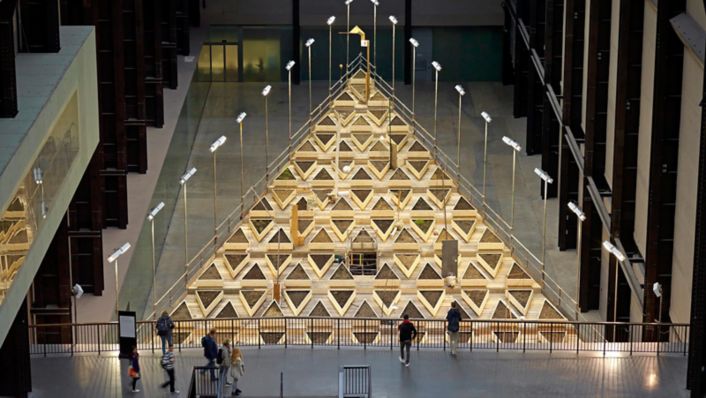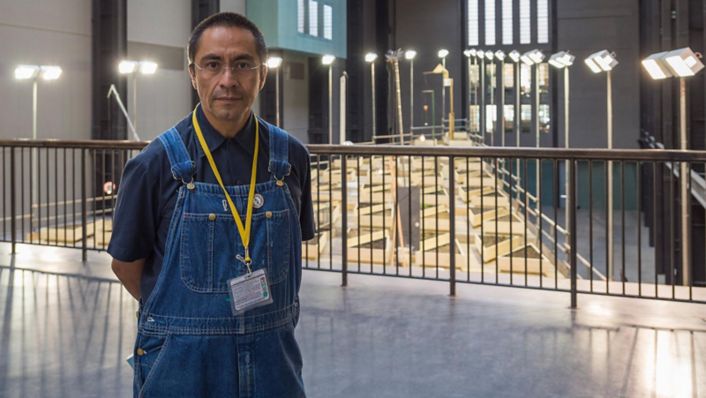- Hyundai Commission unveiled in the Turbine Hall at Tate Modern exploring chance, change, and hope
- Artist Abraham Cruzvillegas presents his new sculpture to global audience of art and culture
- Hyundai Commission will be a key part of the 11-year partnership with Tate, representing Hyundai Motor’s global effort to enable better access to experiencing art
Press material
-
Download
-
Images
Hyundai Motor and Tate Modern today unveiled the inaugural Hyundai Commission in the Turbine Hall
The Hyundai Commission will be part of a unique long-term partnership - running until 2025 - between Tate and Hyundai Motor. To mark the start of the partnership, Hyundai Motor supported significant acquisition of works by Korean artist Nam June Paik (1932 - 2006) in November of 2014. Spanning the 40-year career of the pioneering video artist, nine of his creations are now on display at Tate Modern.
Created by conceptual artist, Abraham Cruzvillegas (b.1968, Mexico City), ‘Empty Lot’ is the first in a new series of annual site-specific commissions by renowned international artists. The Turbine Hall’s new large sculpture provokes questions about the city and nature, as well as wider ideas of chance, change, and hope.
Consisting of two stepped triangular platforms that extend across Tate Modern’s iconic Turbine Hall, the sculpture invites visitors to wander through the supporting scaffolding and explore underneath the platforms, and also view the work from above on the Turbine Hall bridge. The platforms hold a geometric grid of 240 wooden planters filled with compost and over 23 tonnes of soil collected from parks and gardens all across London from Peckham Rye to Regent’s Park.
Created by conceptual artist, Abraham Cruzvillegas (b.1968, Mexico City), ‘Empty Lot’ is the first in a new series of annual site-specific commissions by renowned international artists. The Turbine Hall’s new large sculpture provokes questions about the city and nature, as well as wider ideas of chance, change, and hope.
Consisting of two stepped triangular platforms that extend across Tate Modern’s iconic Turbine Hall, the sculpture invites visitors to wander through the supporting scaffolding and explore underneath the platforms, and also view the work from above on the Turbine Hall bridge. The platforms hold a geometric grid of 240 wooden planters filled with compost and over 23 tonnes of soil collected from parks and gardens all across London from Peckham Rye to Regent’s Park.

I believe our work at Hyundai Motor goes beyond creating cars, as they are no longer simply a mode of transportation but an integral part of connecting our lives. In a collaborative spirit with Tate, we are eager to foster meaningful interaction and want to create inspiring moments.
Abraham Cruzvillegas is best known for creating sculptural works from local objects, some found, some bought. For the duration of the project, the soil will be lit by lampposts constructed by the artist using materials from skips and building sites around Tate. Nothing has been planted by the artist, but flowers, mushrooms, and other greenery may grow depending on what seeds or bulbs have found their way into the soil. Cruzvillegas explores ideas of unpredictability and hope, inviting visitors to see the sculpture changing from one week to the next. In the middle of a busy commercial area of London, the ‘empty lot’ is a space where nothing is produced but where change might happen.
Many of the artist’s interests are embodied in this project, from seed bombing and guerrilla gardening to ancient ‘chinampas’, small grids of earth used to grow corn, peppers and tomatoes in the area that later became Mexico City. The triangular shape evokes a giant compass, pointing east and west, but also recalls the strong diagonals used by Russian avant-garde artists such as El Lissitsky and the work of the visionary architect Buckminster Fuller whose geodesic dome designs comprised intersecting triangular elements.
Many of the artist’s interests are embodied in this project, from seed bombing and guerrilla gardening to ancient ‘chinampas’, small grids of earth used to grow corn, peppers and tomatoes in the area that later became Mexico City. The triangular shape evokes a giant compass, pointing east and west, but also recalls the strong diagonals used by Russian avant-garde artists such as El Lissitsky and the work of the visionary architect Buckminster Fuller whose geodesic dome designs comprised intersecting triangular elements.

During the 1990s and 2000s, Cruzvillegas was among the key figures of a new wave of artists in Mexico. For the past few years, he has created a body of work under the title ‘Autoconstrucción’ or ‘self-construction’, a term that usually refers to the way Mexicans of his parents’ generation, arriving in the capital from rural areas in the 1960s, built their own houses in stages, improvising with whatever materials they could source.
Cruzvillegas was born in 1968 in Mexico City, where he continues to live and work. He is represented in several major museum collections, including Tate and MoMA, New York, and in recent years his work has been exhibited at Haus der Kunst, Munich (2014); Walker Art Center, Minneapolis (2013); and Modern Art Oxford (2011).
Cruzvillegas was born in 1968 in Mexico City, where he continues to live and work. He is represented in several major museum collections, including Tate and MoMA, New York, and in recent years his work has been exhibited at Haus der Kunst, Munich (2014); Walker Art Center, Minneapolis (2013); and Modern Art Oxford (2011).

To offer better access to experiencing art, Hyundai Motor has also initiated partnerships with the National Museum of Modern and Contemporary Art Korea (MMCA), the Los Angeles County Museum of Art (LACMA) and Bloomberg. With MMCA, Hyundai Motor offers a decade long platform for Korean artists. At the Los Angeles County Museum of Art, The Hyundai Project explores two significant fields - Art + Technology and Korean Art Scholarship - through acquisitions, exhibitions, and publications. Brilliant Ideas looks at some of the most exciting artists to extend ground breaking ideas to the international audience in collaboration with Bloomberg. Hyundai Motor will continue its support for the global art communities with a strong belief in the need to enable creative experiences in all areas of the world.
Car design and art are about forward thinking and an expression of our lives and emotions. Tate and Hyundai Motor share a commitment to innovation, exploring creative ideas from around the world. Through our arts engagement, we are finding new ways to offer new experiences and values to our customers, and to present our brand to a new audience.
The iconic Turbine Hall measures an impressive 35 meters in height by 152 meters in length and has hosted some of the most memorable and acclaimed works of contemporary art. The magnificent installations, specially commissioned for the space, have delivered dramatic experiences to an audience of millions while changing perceptions of art. The annual Hyundai Commission allows global artists to take on the challenge of interpreting the unique atmosphere of the Turbine Hall while inviting the audience to witness how art evolves throughout a decade.
Image Credits: Hyundai Commission 2015 / Abraham Cruzvillegas: Empty Lot / © Abraham Cruzvillegas / Photo credit: Andrew Dunkley ©TATE 2015 / Further terms of usage in the download section










